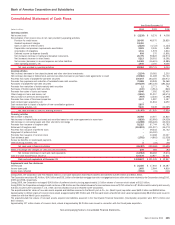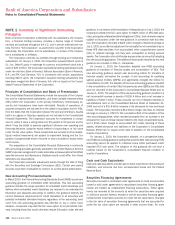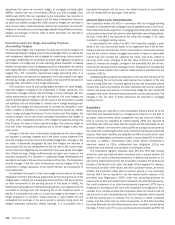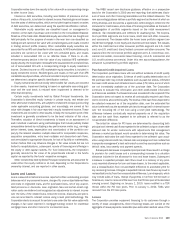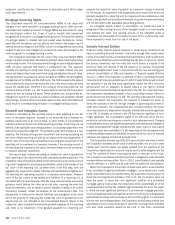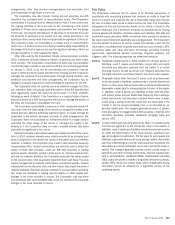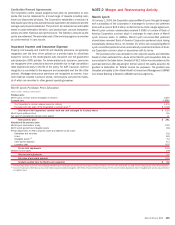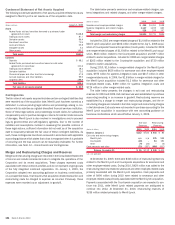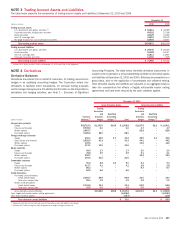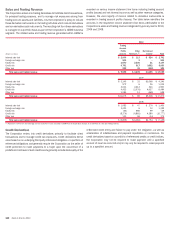Bank of America 2010 Annual Report Download - page 156
Download and view the complete annual report
Please find page 156 of the 2010 Bank of America annual report below. You can navigate through the pages in the report by either clicking on the pages listed below, or by using the keyword search tool below to find specific information within the annual report.Income Taxes
There are two components of income tax expense: current and deferred.
Current income tax expense approximates taxes to be paid or refunded for the
current period. Deferred income tax expense results from changes in deferred
tax assets and liabilities between periods. These gross deferred tax assets
and liabilities represent decreases or increases in taxes expected to be paid
in the future because of future reversals of temporary differences in the
bases of assets and liabilities as measured by tax laws and their bases as
reported in the financial statements. Deferred tax assets are also recognized
for tax attributes such as net operating loss carryforwards and tax credit
carryforwards. Valuation allowances are recorded to reduce deferred tax
assets to the amounts management concludes are more-likely-than-not to
be realized.
Income tax benefits are recognized and measured based upon a two-step
model: 1) a tax position must be more-likely-than-not to be sustained based
solely on its technical merits in order to be recognized, and 2) the benefit is
measured as the largest dollar amount of that position that is more-likely-than-
not to be sustained upon settlement. The difference between the benefit
recognized and the tax benefit claimed on a tax return is referred to as an
unrecognized tax benefit (UTB). The Corporation records income tax-related
interest and penalties, if applicable, within income tax expense.
Retirement Benefits
The Corporation has established retirement plans covering substantially all
full-time and certain part-time employees. Pension expense under these
plans is charged to current operations and consists of several components
of net pension cost based on various actuarial assumptions regarding future
experience under the plans.
In addition, the Corporation has established unfunded supplemental
benefit plans and supplemental executive retirement plans (SERPs) for se-
lected officers of the Corporation and its subsidiaries that provide benefits
that cannot be paid from a qualified retirement plan due to Internal Revenue
Code restrictions. The Corporation’s current executive officers do not earn
additional retirement income under SERPs. These plans are nonqualified
under the Internal Revenue Code and assets used to fund benefit payments
are not segregated from other assets of the Corporation; therefore, in general,
a participant’s or beneficiary’s claim to benefits under these plans is as a
general creditor. In addition, the Corporation has established several postre-
tirement healthcare and life insurance benefit plans.
Accumulated Other Comprehensive Income
The Corporation records unrealized gains and losses on AFS debt and mar-
ketable equity securities, gains and losses on cash flow accounting hedges,
unrecognized actuarial gains and losses, transition obligation and prior ser-
vice costs on pension and postretirement plans, foreign currency translation
adjustments and related hedges of net investments in foreign operations in
accumulated OCI, net-of-tax. Unrealized gains and losses on AFS debt and
marketable equity securities are reclassified to earnings as the gains or
losses are realized upon sale of the securities. Unrealized losses on AFS
securities deemed to represent OTTI are reclassified to earnings at the time of
the impairment charge. Beginning in 2009, for AFS debt securities that the
Corporation does not intend to sell or it is not more-likely-than-not that it will be
required to sell, only the credit component of an unrealized loss is reclassified
to earnings. Gains or losses on derivatives accounted for as cash flow hedges
are reclassified to earnings when the hedged transaction affects earnings.
Translation gains or losses on foreign currency translation adjustments are
reclassified to earnings upon the substantial sale or liquidation of invest-
ments in foreign operations.
Earnings Per Common Share
Earnings per share (EPS) is computed by dividing net income (loss) allocated
to common shareholders by the weighted-average common shares outstand-
ing. Net income (loss) allocated to common shareholders represents net
income (loss) applicable to common shareholders which is net income (loss)
adjusted for preferred stock dividends including dividends declared, accretion
of discounts on preferred stock including accelerated accretion when pre-
ferred stock is repaid early, and cumulative dividends related to the current
dividend period that have not been declared as of period end, less income
allocated to participating securities (see below for additional information).
Diluted earnings (loss) per common share is computed by dividing income
(loss) allocated to common shareholders by the weighted-average common
shares outstanding plus amounts representing the dilutive effect of stock
options outstanding, restricted stock, restricted stock units, outstanding
warrants and the dilution resulting from the conversion of convertible pre-
ferred stock, if applicable.
On January 1, 2009, the Corporation adopted new accounting guidance on
earnings per share that defines unvested share-based payment awards that
contain nonforfeitable rights to dividends as participating securities that are
included in computing EPS using the two-class method. The two-class method
is an earnings allocation formula under which EPS is calculated for common
stock and participating securities according to dividends declared and par-
ticipating rights in undistributed earnings. Under this method, all earnings,
distributed and undistributed, are allocated to participating securities and
common shares based on their respective rights to receive dividends.
In an exchange of non-convertible preferred stock, income allocated to
common shareholders is adjusted for the difference between the carrying
value of the preferred stock and the fair value of the common stock ex-
changed. In an induced conversion of convertible preferred stock, income
allocated to common shareholders is reduced by the excess of the fair value
of the common stock exchanged over the fair value of the common stock that
would have been issued under the original conversion terms.
Foreign Currency Translation
Assets, liabilities and operations of foreign branches and subsidiaries are
recorded based on the functional currency of each entity. For certain of the
foreign operations, the functional currency is the local currency, in which case
the assets, liabilities and operations are translated, for consolidation pur-
poses, from the local currency to the U.S. dollar reporting currency at period-
end rates for assets and liabilities and generally at average rates for results of
operations. The resulting unrealized gains or losses as well as gains and
losses from certain hedges, are reported as a component of accumulated OCI
on an after-tax basis. When the foreign entity’s functional currency is deter-
mined to be the U.S. dollar, the resulting remeasurement currency gains or
losses on foreign currency-denominated assets or liabilities are included in
earnings.
Credit Card and Deposit Arrangements
Endorsing Organization Agreements
The Corporation contracts with other organizations to obtain their endorse-
ment of the Corporation’s loan and deposit products. This endorsement may
provide to the Corporation exclusive rights to market to the organization’s
members or to customers on behalf of the Corporation. These organizations
endorse the Corporation’s loan and deposit products and provide the Corpo-
ration with their mailing lists and marketing activities. These agreements
generally have terms that range from two to five years. The Corporation
typically pays royalties in exchange for the endorsement. Compensation
costs related to the credit card agreements are recorded as contra-revenue
in card income.
154 Bank of America 2010



